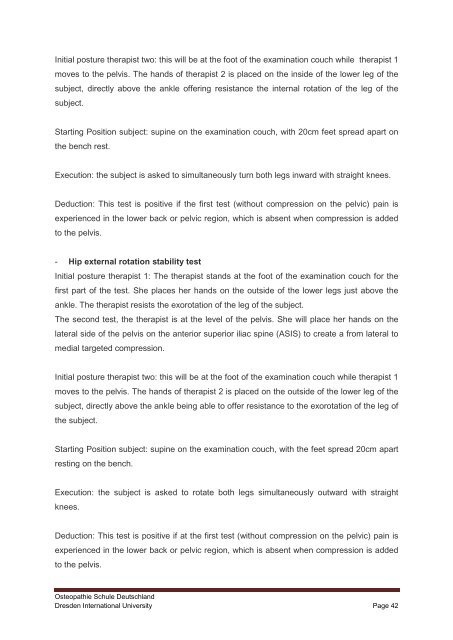Pelvic girdle pain and relevance of ASLR testing: A ... - Cindy Verheul
Pelvic girdle pain and relevance of ASLR testing: A ... - Cindy Verheul
Pelvic girdle pain and relevance of ASLR testing: A ... - Cindy Verheul
You also want an ePaper? Increase the reach of your titles
YUMPU automatically turns print PDFs into web optimized ePapers that Google loves.
Initial posture therapist two: this will be at the foot <strong>of</strong> the examination couch while therapist 1<br />
moves to the pelvis. The h<strong>and</strong>s <strong>of</strong> therapist 2 is placed on the inside <strong>of</strong> the lower leg <strong>of</strong> the<br />
subject, directly above the ankle <strong>of</strong>fering resistance the internal rotation <strong>of</strong> the leg <strong>of</strong> the<br />
subject.<br />
Starting Position subject: supine on the examination couch, with 20cm feet spread apart on<br />
the bench rest.<br />
Execution: the subject is asked to simultaneously turn both legs inward with straight knees.<br />
Deduction: This test is positive if the first test (without compression on the pelvic) <strong>pain</strong> is<br />
experienced in the lower back or pelvic region, which is absent when compression is added<br />
to the pelvis.<br />
- Hip external rotation stability test<br />
Initial posture therapist 1: The therapist st<strong>and</strong>s at the foot <strong>of</strong> the examination couch for the<br />
first part <strong>of</strong> the test. She places her h<strong>and</strong>s on the outside <strong>of</strong> the lower legs just above the<br />
ankle. The therapist resists the exorotation <strong>of</strong> the leg <strong>of</strong> the subject.<br />
The second test, the therapist is at the level <strong>of</strong> the pelvis. She will place her h<strong>and</strong>s on the<br />
lateral side <strong>of</strong> the pelvis on the anterior superior iliac spine (ASIS) to create a from lateral to<br />
medial targeted compression.<br />
Initial posture therapist two: this will be at the foot <strong>of</strong> the examination couch while therapist 1<br />
moves to the pelvis. The h<strong>and</strong>s <strong>of</strong> therapist 2 is placed on the outside <strong>of</strong> the lower leg <strong>of</strong> the<br />
subject, directly above the ankle being able to <strong>of</strong>fer resistance to the exorotation <strong>of</strong> the leg <strong>of</strong><br />
the subject.<br />
Starting Position subject: supine on the examination couch, with the feet spread 20cm apart<br />
resting on the bench.<br />
Execution: the subject is asked to rotate both legs simultaneously outward with straight<br />
knees.<br />
Deduction: This test is positive if at the first test (without compression on the pelvic) <strong>pain</strong> is<br />
experienced in the lower back or pelvic region, which is absent when compression is added<br />
to the pelvis.<br />
Osteopathie Schule Deutschl<strong>and</strong><br />
Dresden International University Page 42


